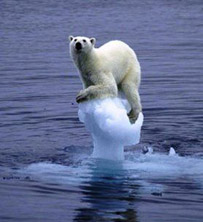International Polar Year climate research begins
 Ottawa, Canada (GLOBE-Net) – International Polar Year (2007-2008), a comprehensive scientific research effort focused on the Arctic and Antarctic regions, with a specific focus on climate change, has officially begun, with funding from the Canadian government directed at a number of projects.
Ottawa, Canada (GLOBE-Net) – International Polar Year (2007-2008), a comprehensive scientific research effort focused on the Arctic and Antarctic regions, with a specific focus on climate change, has officially begun, with funding from the Canadian government directed at a number of projects.
The International Polar Year (IPY) program will include thousands of scientists and researchers from more than 60 nations conducting a wide range of projects spanning a 24-month period beginning March 2007. The effort is only the third such undertaking since the IPY was launched. The last such effort took place in 1932-33.
Given technological advances that make living in and researching the polar regions easier, scientists are hopeful that they can shed some insight on some pressing issues. The Canadian government has identified two priority areas for its research: climate change impacts and adaptation, and the health and well-being of Northern communities.
With a total contribution of $150 million in federal funding, 44 Canadian science and research projects were selected for the International Polar Year (IPY) 2007-2008.
The single largest project is the Circumpolar Flaw Lead System Study led by David Barber from the University of Manitoba, a $40 million study involving more than 200 researchers from 14 countries. The team will use a retrofitted icebreaker to study the Arctic environment and the shrinking sea ice, focusing on the flaw lead system - a unique area where open water persists throughout the winter. A full list of the projects can be found here.
The importance of the polar regions has becoming increasingly noted by scientists as those areas are displaying rapid changes resulting from climate change. In Canada, the Arctic is warming at a faster rate than the rest of the globe, and may experience widespread ecological changes if this trend continues. Research undertaken as part of IPY will contribute to the body of knowledge on the Arctic region, and may bring new insights on climate change and its future effects.
The most comprehensive scientific study of the melting Arctic to date, the Arctic Climate Impact Assessment, was delivered in 2004, and detailed a number of projected consequences of rising Arctic temperatures. The study was reinforced by recent studies which show dramatically decreasing summer sea-ice levels and warming temperatures.
European scientists reported in September 2006 dramatic openings over large areas of the Arctic’s perennial sea ice pack in August and another study found that Greenland’s ice sheet is melting far faster than scientists had previously thought.
Two other studies published last year by NASA scientists confirm that Arctic sea ice is melting at extraordinary rates. One study found that the total amount of Arctic sea ice has fallen by 6 percent over each of the last two winters, compared to a loss of 1.5 percent per decade since 1979.
The second study revealed that perennial sea ice in the Arctic shrank by 14 percent between 2004 and 2005, a striking change compared to the period between 1979 to 2003, when perennial ice decreased at a rate of 9 percent per decade.
As the ice retreats, new areas will be opened up for transportation, resource extraction, and development. Canada will be at the forefront of the environmental and economic fallout of these impending changes.
In the IPY effort, Canada will play a key role, undertaking research projects as well as hosting a number of international teams to provide access to the Arctic region. More information can be found at the federal IPY website.
For More Information: Government of Canada
You can return to the main Market News page, or press the Back button on your browser.

